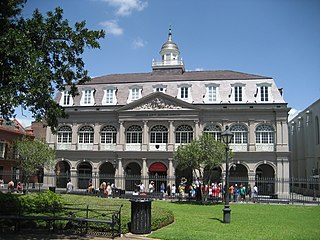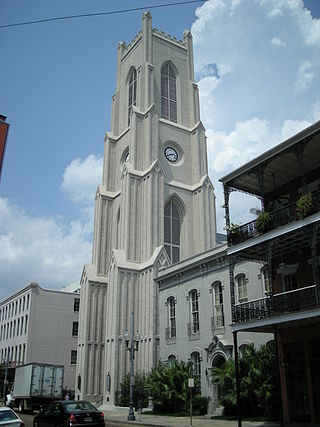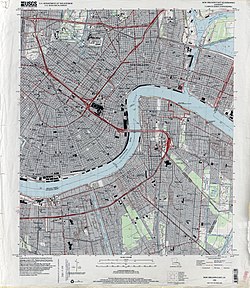
The French Quarter, also known as the Vieux Carré, is the oldest neighborhood in the city of New Orleans. After New Orleans was founded in 1718 by Jean-Baptiste Le Moyne de Bienville, the city developed around the Vieux Carré, a central square. The district is more commonly called the French Quarter today, or simply "The Quarter", related to changes in the city with American immigration after the 1803 Louisiana Purchase. Most of the extant historic buildings were constructed either in the late 18th century, during the city's period of Spanish rule, or were built during the first half of the 19th century, after U.S. purchase and statehood.

The Cabildo, originally called "Casa Capitular", is a historical building in New Orleans, Louisiana. Originally the seat of Spanish colonial city hall, the building now forms part of the Louisiana State Museum. It is located along Jackson Square, adjacent to St. Louis Cathedral.

James Gallier was a prominent nineteenth-century Irish-born American architect, most famed for his buildings in New Orleans. Gallier Hall, which he designed and once served as New Orleans City Hall, is named after him.
Fort Charlotte, Mobile is a partially-reconstructed 18th-century fort in Mobile, Alabama.

The Great New Orleans Fire (1788) was a fire that destroyed 856 of the 1,100 structures in New Orleans, Louisiana, on March 21, 1788, spanning the south central Vieux Carré from Burgundy to Chartres Street, almost to the Mississippi River front buildings. An additional 212 buildings were destroyed in a later citywide fire, on December 8, 1794.

In the law regulating historic districts in the United States, a contributing property or contributing resource is any building, object, or structure which adds to the historical integrity or architectural qualities that make the historic district significant. Government agencies, at the state, national, and local level in the United States, have differing definitions of what constitutes a contributing property but there are common characteristics. Local laws often regulate the changes that can be made to contributing structures within designated historic districts. The first local ordinances dealing with the alteration of buildings within historic districts was enacted in Charleston, South Carolina in 1931.

National American Bank Building is a 23-story 325 feet (99 m)-tall skyscraper in the Central Business District of New Orleans, Louisiana, It was completed in 1929 and listed on the National Register of Historic Places in 1986. It is topped with a distinctive 6-story octagonal tower with a golden Art Deco finial. Its address is 200 Carondelet Street. Originally a commercial building, it was renovated for use as a residential building after Hurricane Katrina.

The Presbytère is an architecturally important building in the French Quarter of New Orleans, Louisiana. It stands facing Jackson Square, adjacent to the St. Louis Cathedral. Built in 1813 as a matching structure for the Cabildo, which flanks the cathedral on the other side, it is one of the nation's best examples of formal colonial Spanish architecture. It was designated a National Historic Landmark in 1970, and is now a property of the Louisiana State Museum.

St. Patrick's Church is a Catholic church and parish in the Archdiocese of New Orleans, Louisiana, United States. The parish was founded in 1833, and the current structure was completed in 1840. It is the second-oldest parish in New Orleans, located upriver from the French Quarter at 724 Camp Street in what is now the Central Business District. The building, a National Historic Landmark, is one of the nation's earliest and finest examples of Gothic Revival architecture.

The buildings and architecture of New Orleans reflect its history and multicultural heritage, from Creole cottages to historic mansions on St. Charles Avenue, from the balconies of the French Quarter to an Egyptian Revival U.S. Customs building and a rare example of a Moorish revival church.

Frenchmen Street is in the 7th Ward of New Orleans, Louisiana. It is best known for the three-block section in the Faubourg Marigny neighborhood which since the 1980s has developed as the center of many popular live-music venues, including Cafe Negril, Favela Chic, Vaso, Apple Barrel, Blue Nile, Snug Harbor, the Spotted Cat, and the Maison. In addition the street has numerous restaurants, bars, a premier bicycle shop, a record store, a book shop, and other local businesses.

The Napoleon House, also known as the Mayor Girod House or Nicolas Girod House, is a historic building at 500 Chartres Street in the French Quarter of New Orleans, Louisiana, United States. Built in 1794 and enlarged in 1814, its name derives from the local legend that it was intended as a residence for Napoleon Bonaparte after his exile. A plan to bring Napoleon to Louisiana was halted by news of his death in 1821.

Ursuline Convent was a series of historic Ursuline convents in New Orleans, Louisiana, United States. In 1727, at the request of Governor Étienne Perier, nuns from the Ursuline Convent of Rouen (Normandy) went to New Orleans to found a convent, run a hospital, and take care of educating young girls.

Vieux Carré Property Owners, Residents, and Associates (VCPORA), organized in the 1920s, is a pioneer organization in the historic preservation movement that grew out of several grass roots efforts to protect the 200-year-old Vieux Carré from decay and demolition. In 1936 the Louisiana state legislature passed a constitutional amendment authorizing the historic preservation of the Vieux Carré. Two years later on June 8, 1938 the neighborhood organization incorporated as a non-profit dedicated to the preservation, restoration, beautification and general betterment of the Vieux Carré.

Exchange Place, also known as Exchange Alley and Exchange Passage, is a pedestrian zone that was created in 1831 originally as a small street in the French Quarter of New Orleans, Louisiana. Its original name was Passage de la Bourse, or Exchange Passage. The street was commissioned by the banker and merchant Samuel Jarvis Peters, who thought to build an exchange closer to Canal Street. It was built in coherence with the Merchants' Exchange Building on Royal Street as it acted as a back entrance. The street has been a hidden alleyway to many shops and restaurants over the years.

The U.S. Custom House, also known as the Old Post Office and Custom House, is a historic government building at 423 Canal Street in New Orleans, Louisiana. It was designated a National Historic Landmark, receiving this designation in 1974 and noted for its Egyptian Revival columns. Construction on the building, designed to house multiple federal offices and store goods, began in 1848 and didn't finish until 1881 due to redesigns and the American Civil War. The U.S. Customs offices have been located there since the late 19th century.

The Bank of Louisiana building is located at 334 Royal Street in the French Quarter of New Orleans, Louisiana. It was added to the National Register of Historic Places in 1973.

The New Orleans Lower Central Business District is a historic district in New Orleans, Louisiana which was listed on the National Register of Historic Places (NRHP) in 1991. It may be referred to as Lower Central Business District. Along with the NRHP-listed New Orleans Upper Central Business District to the south, across the redeveloped Poydras Street, it is included within the larger New Orleans Central Business District area. To the north, between N. Peters and N. Rampart, the district borders the historic, NRHP-listed Vieux Carre, which is a U.S. National Historic Landmark.
Richard Koch was an architect who specialized in architectural conservation and the restoration of historically significant buildings. He emphasized buildings in New Orleans, Louisiana. Koch worked with the Historic American Buildings Survey (HABS) during the Great Depression. He was an early leader of the Vieux Carré Commission.

In New Orleans, a gallery is a wide platform projecting from the wall of a building supported by posts or columns. Galleries are typically constructed from cast iron with ornate balusters, posts, and brackets.





















